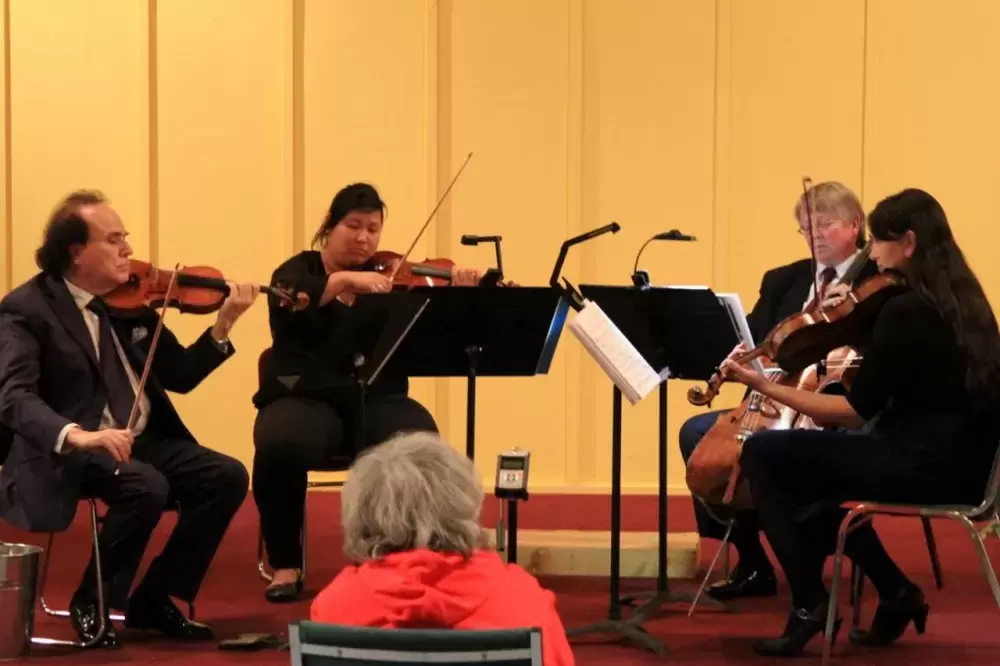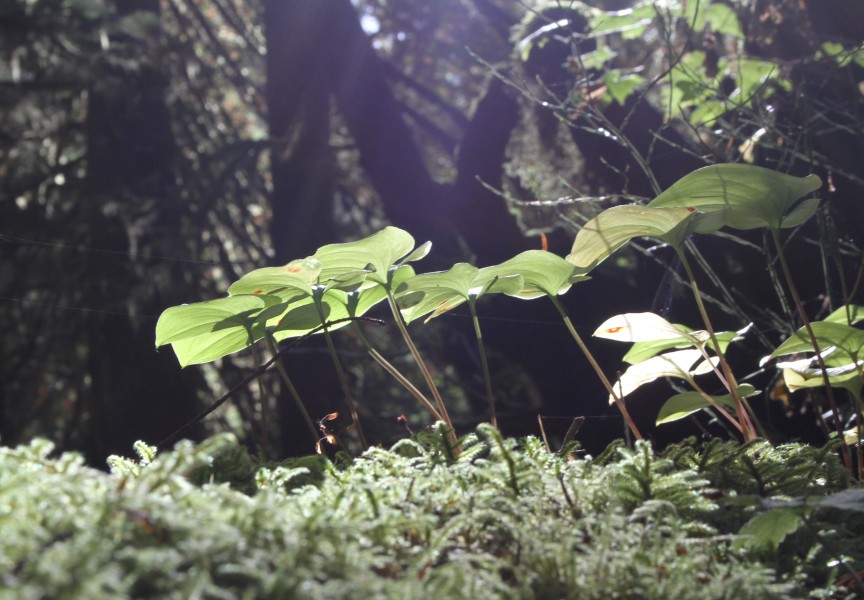A simple child grows to be a simple man, is sacrificed and hanged unjustly, leaving nothing of his life behind but a legacy of sorrow.
Until now.
Kahtkayna, a “simpleton of inferior rank… so worthless that not one woman of his tribe would take him as a husband,” is the unlikely inspiration of a concerto by composer Brent Straughan of Sooke, B.C.
Cradle Song for the Useless Man was performed by the DieMahler Quartet at the Alberni Valley United Church Nov. 27. The performance was hosted by Chief Victor Amos and the Amos family of Hesquiaht. A family turkey dinner topped off the event.
Kahtkayna is forever tied to Amos family ancestor John Anietshachist and to the fate of the John Bright, an English-registered trading ship that ran into a storm at Estevan Point off the West Coast of Vancouver Island in February 1869.
Passengers and crew were lost to the waves and the rocks along that rugged coastline. A deadly brew of rumour, lies and speculation would sweep the lives of Kahtkayna and Anietshachist away in the aftermath, charged and convicted of the “willful murder” of the John Bright ‘survivors,’ killed as they struggled from the surf to the shore by “West Coast savages,” or so it was alleged.
Last May, while Victor Amos was getting organized to open his floating café Coppermoon at Hot Springs Cove, he got a phone call from a stranger out of the blue.
“‘Hi, my name is Brent Straughan’, he says, ‘I’ve composed music to tell the story about Kahtkayna,’” Victor told the gathering.
Many had stood and fought for Anietshachist’s name over the years. In 2012, after a decade of concerted effort to clear his name, the government of British Columbia finally acknowledged the injustice of Anietshachist’s demise, stating regret for the trial and what the family was put through, ordered by the colonial government to watch as their relative was put to a gruesome death.
But though the regret extends to Kahtkayna, he has not been represented.
“The name of Kahtkayna really settled in my heart because he represents so many children who didn’t come home or other stories on our coast,” said Rick Lindholm, who was asked by the family to say a prayer over the gathering.
“We felt bad about Kahtkayna,” said Vic, “because I still can’t see anybody today who can say ‘I’m related to that man’… So Brent, you come here to represent Kahtkayna today.
You are going to tell a story that’s important to us.”
Straughan said it was a privilege to look into the faces of people directly related “to the stories I’ve imagined so many times and tried to think of a way to reflect it back in music.”
He said the story of Kahtkayna was biblical in scope, “sacrificed by his tribe to stop the colonial officials from burning villages and cannonading canoes.” Anietshachist was given up to the British by a tribal enemy.
Straughan said his creation was eight years in the making, from hearing the story of Anietshachist and Kahtkayna to standing at the United Church that day. Two years were a particular struggle.
“I doubted my talent, I got lost in my ideas.” But the wisdom of another would set him on the right path. “Brent, give it a clear voice. You have a clear voice,” he was instructed. He said the resulting work was now part of the Amos family story.
Friday’s performance began with the chant composed by Anietshachist on the gallows in the moments before his death. In the church, holding aloft a crystal and shaking a hide rattle~powerful Nuu-chah-nulth symbols of the sacred~ the chant was sung by Anietshachist descendent Justin Lucas as the string quartet and audience looked on.
The chant professes Anietshachist’s innocence. It says he would always be talked about and that his family would grow in number while his betrayer’s family would be diminished and die out. The chant survived over the generations and Anietshachist’s family thrived and grew.
Straughan said he knew Anietshachist had written a song, but had no idea that it existed today. “What a remarkable thing,” said Straughan, “a fellow composer who composed up until the moment of his death.”
The quartet — violinists Pablo Diemecke and Shima Takeda, cellist Larry Skaggs and, on viola, Elizabeth Massi — performed four movements of the concerto, including an ending democratically selected by vote of the audience. There were three possible endings, titled Salmon, Raven and Kermode Bear.
“The first movement is cradle songs, simple tunes, and that’s Kahtkayna’s childhood,” said Straughan. He said when he first heard the story about Kahtkayna he was haunted by cradle songs. “A simple child, his mother must have sung to him,” he thought.
In the second movement, the British are coming, “and they are coming up the coast in the HMS Sparrowhawk with 50 Royal Marines.” There are rhythms of steam engines and warrior calls and a bit of jazz, Straughan explained. The movement is muscular and energetic, as the Sparrowhawk cuts through West Coast waters to investigate the John Bright deaths.
The third movement combines Kahtkayna’s and John Anietshachist’s stories. They are at the gallows and Kahtkayna is praying to Creator, represented by a song sung by Mezzo Soprano Dawna Beach. It’s a European-style expression of what a Hesquiaht man would be feeling and thinking at a time of imminent peril. Working with family members Hilda Nookemus and Vi George, the closest living descendent of Anietshachist, Straughan was able to put Nuu-chah-nulth words into the work, he said.
“The moment of death comes and there’s a string snap,” and horrible violin sounds as the men are hanged. While Anietshachist died almost immediately, the rope around Kahtkayna’s neck did not draw tight. “He squirmed, gurgled, and choked, dancing grotesquely in space until the executioner raced up the scaffold and jammed his foot downwards against the knot, bringing an end to his suffering,” reads a July 31, 1869 report in the British Colonist newspaper. And Kahtkayna’s final suffering is certainly heard in the music.
The fourth movement is Anietshachist’s and Kahtkayna’s spiritual journey, sometimes uplifting and calming, but not an easy transition home.
The audience chose the salmon ending (because we are salt-water people, said Vic Amos) and finished the concerto as such, but the Raven ending was also played at the request of Vi George. She was brought up to sit before the quartet as they honored her request.
The concert Nov. 27 was entitled Music and Reconciliation, and it may have closed a circle. “You almost feel that the grandparents of the past are involved in this whole thing at a spiritual level,” said Victor Amos.
Witness statements, ignored by the lawful inquest convened by the Attorney General, had put Kahtkayna in Nootka at the time of the John Bright shipwreck and for two weeks after.The Amos family says that while walking along the beach on his way to a gathering, Anietshachist came upon the bodies of two victims of the John Bright wreck. He drew the bodies above the tideline, as was the practice, to deal with after the community feast. The community had a tradition of burying shipwreck victims.
A surgeon who exhumed and examined those bodies testified he found no signs of foul play. His testimony was ignored.
But a medal given to Anietshachist’s son Aime Anutspato by the President of the United States was part of the proof given to the government of British Columbia as they considered an apology for Kahtkayna’s and Anietshachist’s deaths.
On Oct. 10, 1882, the U.S. ship Malleville wrecked near Hesquiaht. Anutspato retrieved the bodies and buried them. He was given the medal from the president and $200 for his humane services.
The medal had been lost to the family in 1964 when a tsunami lifted the home of Aime’s descendants and took it a kilometre out to sea. But 46 years later, a chance meeting at a Port Alberni grocery store, restored the medal to the family.
“One day I was at the grocery store in Quality Foods, and I had a fellow by the name of Art Clarke, he grabbed me gently by the arm and he said to me ‘I want you to come to my place. I have something that belongs to your grandfather’,” Vic said.
When he went over to his house, Art pulled out a gold medal and part of an envelope with the note “This may belong to Alec Amos” written on it. The medal had been noticed in the destruction left behind by the tsunami, tucked away, it seems, until the family required it as proof of what they had been saying all along. The men were innocent.
In an email to Ha-Shilth-Sa after the concert, Stroughan said he was nervous reflecting back someone else’s story. What if he had got it all wrong? But he said it was a profound experience to be welcomed by everyone and to share musical experiences.
“I found Justin’s performance of the ‘Amos chant’ very moving…I had only heard chanting and drumming on recordings before, never in real life with pressure waves from the drums vibrating in my chest? What an experience.
“It’s not a concert I can ever forget.”







